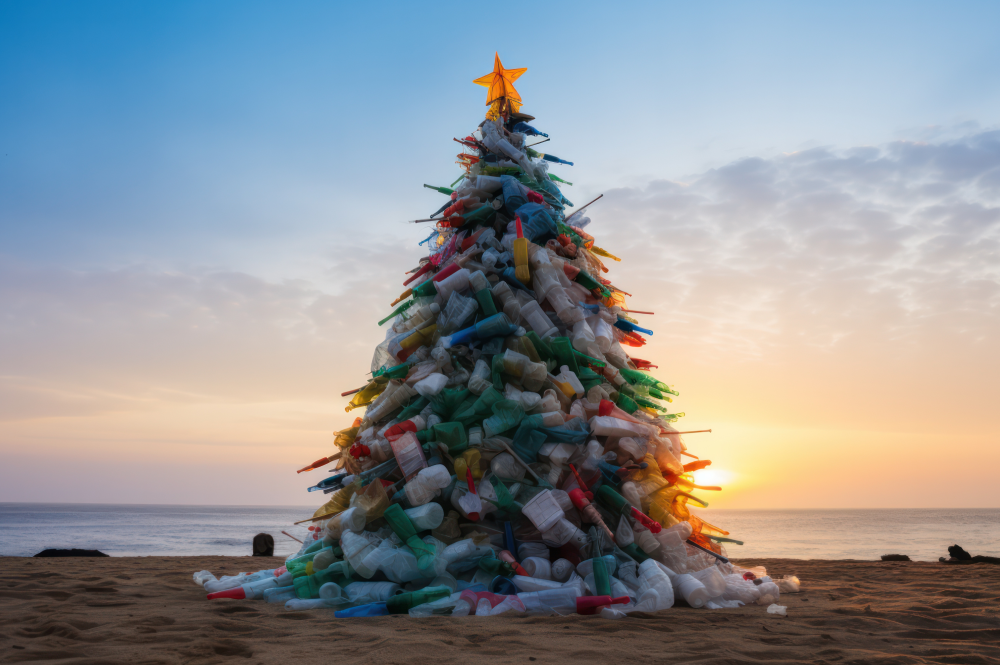Microplastics at Christmas – More Than Meets the Eye

During the festive season, we are surrounded by sparkly decorations and colourful toys, and one thing they all have in common is their use of microplastics.
Definition of Microplastic
Microplastics are debris that are less than 5mm in size, often resulting from the disposal or breakdown of plastic products. Extensive research has been conducted on the impact of microplastics on human health, with results showing that they can disrupt the body’s circulatory, respiratory, and digestive systems.
Microplastics at Christmas
Decorations
One of the most common ways in which plastic is present at Christmas is in tinsel, baubles and faux wreaths. These plastic filled decorations enter our homes and bring with them microplastics that release into the air that we breathe, with many products not being recycled and ending up in landfills.
Glitter is one of the biggest offenders, used in wrapping paper, Christmas cards and decorations. Although the European Commission outlawed the sale of plastics under 5mm that do not dissolve or break down naturally, this does not apply to the UK as we are no longer part of the European Union. Additionally, glitter is known for easily spreading, contaminating other materials in the recycling bin, meaning none of it can be recycled.
As is tradition, Christmas crackers are used up and down the country (and throughout the world, with an estimated 40 million Christmas crackers ending up in the bin each year)1 which are often made from plastic, featuring small plastic toys inside that often get left on the Christmas table and forgotten about.
Not only are all these products bad for the environment in terms of waste, but it also raises the question of the time and resources used to create these items that are only used once.
Real Christmas Trees
Surely a real tree can’t contain plastic? Unfortunately, the netting that you usually find on your real Christmas tree is made from plastic, which then goes into the bin, ending up in landfill. Although biodegradable netting is available it is not mainstream yet.
Of course, if you’re going for an artificial tree alternative, they are made from polyvinyl chloride (PVC) or polypropylene.
Food Plastic
A quick trip to the supermarket shows how evident plastic is, with most of the food being wrapped in plastic packaging and bags. Not only does this release tiny bits of plastic onto the food, but the plastic could be inside of the food we ingest, due to plastic ending up in oceans which is consumed by marine life, which we then consume ourselves.
Additionally, increased plastic fibres in the air cause us to inhale and ingest them, with a recent study showing that 100 microplastic fibres deposit on the UK dinner plate during a 20-minute Christmas dinner.2
Wrapping paper
A common misconception is that all wrapping paper can be recycled, however this couldn’t be further from the truth. A large majority of Christmas wrapping paper is made of plastic and foil, with a wax coating or lamination. This paper cannot be recycled, along with any Sellotape left on wrapping paper.
To identify if your wrapping paper can be recycled you can do the Scrunch test – simply scrunch up the paper and if it bounces back to shape, it’s made from mixed materials and cannot be recycled, unless at specialist recycling centres.
Plastic toys
The toy industry is known for its negative environmental impact, due to the use of non-recyclable plastic materials and extensive waste. With plastic toys being durable, colourful and lightweight, it’s no surprise that 95% of children’s soft toys are made from microplastic material. But it’s not only the generic plastic toys that are made of the damaging material, but soft toys also release thousands of microplastics. Plush toys made from polyester are more likely to shed microplastics compared to their tightly woven counterparts, with acrylic insides mimicking wool, releasing them into the air we breathe.
Additionally, popular toys such as building bricks are known to release microplastics due to the friction from the assembly and disassembly, as well as often being chewed by small children.3
The UK toy industry was worth £4 billion in 2023, with products being created at an unsustainable rate, leading to mass waste. These toys often end up in landfill or are burnt, releasing toxins into the atmosphere.
There is some good news – Mattel is intending to use 100% recycled, recyclable, or bio-based plastic materials in products and packaging by 2030.
Tackling Plastic at Christmas
Although most of the responsibility for tackling plastics lies with manufacturers, there are small ways that we can reduce the amount of plastic in our home this festive season. Start by reusing old Christmas decorations or purchasing from charity shops or using second hand and opting for more sustainable options. When sending and wrapping Christmas gifts, choose recyclable paper (and do the scrunch test), or plantable seed paper.
When purchasing toys for family and friends, choose those made from wood, bamboo and recycled plastics, swapping polyester fabrics to natural fibres.
Additionally, continue to purchase loose fruit and veg in the supermarket, visiting butchers that don’t wrap in needless plastic, and utilising refill stations for your store cupboard favourites.
Outlook
Microplastics by degrading and shedding small particles into the environment, are creating a health issue for both humans and animals. By limiting the plastic products that we use and buy, demand for sustainable alternatives will increase, thus helping manufacturers and retailers to make a change.


